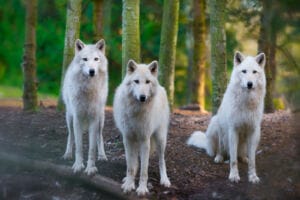The successful resurrection of the dire wolf marks a historic milestone for Colossal Biosciences, but it represents just the beginning of the company’s ambitious vision. Founded in 2021 with the bold tagline of making “extinction optional,” Colossal has established a clear roadmap for bringing back multiple extinct species while simultaneously developing technologies to prevent future extinctions. Let’s explore what’s next on Colossal’s agenda and how the dire wolf achievement fits into their broader mission.
Validating the De-extinction Platform
The birth of three healthy dire wolf pups—Romulus, Remus, and Khaleesi—provides crucial validation of Colossal’s technological approach. As CEO Ben Lamm stated, “This massive milestone is the first of many coming examples demonstrating that our end-to-end de-extinction technology stack works.”
By successfully implementing 20 precise genetic edits across 14 genes—far exceeding the previous record of 8 edits achieved in their “woolly mouse”—Colossal has demonstrated that their platform can handle the complexity required for meaningful de-extinction work. This technical validation boosts confidence in the company’s ability to tackle even more ambitious targets on their roadmap.
DEEPER DIVE: Read all the Ranking Arizona Top 10 lists here
The Woolly Mammoth: Colossal’s Flagship Project
While the dire wolf has captured headlines as the first successfully de-extinct animal, Colossal’s most widely publicized goal remains the resurrection of the woolly mammoth. The company aims to reintroduce the woolly mammoth by 2028, applying similar methods to those used for the dire wolf but at a much larger scale.
Progress on the mammoth front is already well underway. In early 2025, Colossal demonstrated advancement by creating 38 “woolly mice”—laboratory mice edited with mammoth genes to grow shaggy coats—as a proof of concept. The company plans to attempt an elephant pregnancy with a mammoth-variant embryo by 2026, suggesting confidence that their technologies can scale to much larger organisms with more complex genetic requirements.
The mammoth resurrection presents additional challenges beyond those faced with the dire wolf. Elephants have much longer gestation periods (around 22 months compared to the roughly 60-day canid pregnancy), and the size difference between modern elephants and ancient mammoths requires more extensive genetic modifications. However, the success with dire wolves suggests that Colossal’s approach—identifying key genetic variants from ancient DNA and editing them into living relatives—can work across diverse species.
The Tasmanian Tiger (Thylacine)
Another key target in Colossal’s de-extinction pipeline is the thylacine, or Tasmanian tiger, which went extinct in the 1930s. As a more recently extinct species, the thylacine presents different advantages and challenges compared to Ice Age animals like the dire wolf and mammoth.
The relative recency of the thylacine’s extinction means that higher-quality DNA samples are available, potentially allowing for more complete genome reconstruction. Additionally, there are photographs, films, and detailed naturalist accounts of living thylacines, providing precise information about appearance and behavior that must be inferred for more ancient species.
However, the thylacine’s marsupial nature presents unique reproductive challenges. Marsupial development differs significantly from placental mammals, with young born at a very early stage of development before continuing growth in the mother’s pouch. Adapting Colossal’s reproductive technologies for this different biological system will require substantial innovation.
The Dodo: Avian De-extinction
Expanding beyond mammals, Colossal has also announced plans to resurrect the dodo, the iconic flightless bird that went extinct in the 17th century. This project will require adapting their de-extinction platform for avian biology, which differs substantially from mammalian systems in areas like embryonic development and genomic structure.
The dodo represents an important test case for applying de-extinction technologies to birds, potentially opening pathways for addressing the numerous avian extinctions that have occurred in recent centuries, particularly on islands. Success with the dodo could establish protocols relevant to the resurrection or genetic rescue of many bird species.
From Resurrection to Rewilding
Colossal envisions a phased approach to species restoration that extends beyond the initial resurrection of individual animals. For the dire wolf, the company has indicated plans to potentially restore the species in secure and expansive ecological preserves, possibly on indigenous land.
This suggests a long-term vision where de-extinct species eventually return to suitable habitats in managed settings—not unlimited release into the wild, but carefully monitored reintroduction to appropriate ecosystems. This approach recognizes the need to balance the ecological potential of de-extinct species with responsible management.
The company’s partnerships with indigenous communities, including the MHA Nation, the Nez Perce Tribe, and the Karankawa Tribe of Texas, indicate recognition of the cultural and spiritual dimensions of species restoration. These collaborative relationships may shape how and where rewilding of de-extinct species eventually occurs.
Conservation Applications: The Red Wolf Success
Perhaps the most immediate and practical application of Colossal’s de-extinction technology is its potential to help species on the brink of extinction today. Alongside the dire wolf announcement, Colossal revealed they have successfully cloned two litters of critically endangered red wolves using the same non-invasive blood cloning approach developed for the dire wolf work.
With fewer than 20 red wolves remaining in North America, this achievement has immediate conservation significance. All existing red wolves descend from just 12 founder individuals, creating a dangerous genetic bottleneck. Adding Colossal’s red wolves to the captive breeding population would increase the number of founding lineages by 25%, potentially reinvigorating recovery efforts for this critically endangered species.
Dr. Bridgett vonHoldt, a Princeton Associate Professor of Evolutionary Genomics and Epigenetics, highlighted this connection: “I am beyond thrilled that such technologies are also being leveraged to support programs of preventing extinction in endangered species like the red wolf.”
“Ghost” DNA Recovery
Beyond cloning endangered animals, Colossal is pioneering the recovery of “ghost” DNA—genetic diversity that exists in related populations but has been lost from endangered species through population bottlenecks. Their work with the red “ghost” wolf—unique canids found on the Gulf Coast of Texas and Louisiana that carry lost DNA and biodiversity of the red wolf—exemplifies this approach.
By identifying and potentially incorporating genetic diversity from these related populations, Colossal aims to strengthen the genetic health of endangered species. This technique could become a new paradigm in conservation biology: using genomic technology to recover lost genetic variation and enhance the resilience of vulnerable wildlife.
Mike Phillips, Director of the Turner Endangered Species Fund, noted the broader applications: “Perfecting genomic tools to integrate ‘ghost alleles’ from Gulf Coast canids would increase red wolf genetic diversity and generate knowledge for recovering other imperiled species, like the bolson tortoise, that are compromised by restricted ranges and reduced genetic diversity.”
Genetic Rescue of Threatened Species
Colossal is also applying their gene-editing expertise to species that, while not extinct, suffer from severe genetic limitations. The company is working on projects like the pink pigeon—a bird species that has survived a severe genetic bottleneck. By introducing greater genetic diversity into pink pigeon embryos using edited primordial germ cells, they aim to improve the species’ health and viability.
This approach—using genomic techniques to revive lost genetic variation and enhance resilience—could become a standard tool in conservation biology. The technology stack developed for de-extinction potentially offers a way to address inbreeding depression and low genetic diversity in many endangered species.
Biobanking for the Future
An essential component of Colossal’s long-term vision is the development of comprehensive biobanking infrastructure. Their novel approach to establishing cell lines directly from blood draws represents a significant advancement for preserving genetic material from threatened species.
These isolated endothelial progenitor cells (EPCs) can be frozen for later genomic analyses and, as now demonstrated, can be used for cloning. This creates a genetic safety net for endangered species, potentially allowing future restoration even if populations continue to decline.
Matt James, Colossal’s Chief Animal Officer, emphasized this aspect: “The creation of less-invasive sampling tools such as our EPC blood cloning platform allows for the conservation community to ramp up biobanking efforts of those species on the brink.”
Funding and Commercial Strategy
In January 2025, even before the dire wolf announcement, Colossal raised an additional $200 million in financing to accelerate its de-extinction projects. The successful resurrection of the dire wolf will likely further galvanize investor support for the company’s ambitious roadmap.
While the commercial applications of de-extinction may not be immediately obvious, the technologies developed along the way have significant potential value in areas like gene therapy, reproductive medicine, and conservation. Colossal’s approach of tackling high-profile de-extinction targets while simultaneously developing practical applications for endangered species conservation represents a balanced strategy for technological development and real-world impact.
A Vision of Restored Ecosystems
The ultimate vision emerging from Colossal’s work extends beyond individual species resurrection to the restoration of functional ecosystems with their historical biodiversity. As Dan Flores, A. B. Hammond Professor Emeritus of the History of the American West, reflected: “If I were looking 100 years out, I would say that we’re very likely to have animals once again that we thought were always gone—just as I once thought I was never going to get to hear a wolf howl… And so, that makes me think that more and more, we’re going to get to experience what Henry David Thoreau lamented back in the 1850s—that he wasn’t getting to experience an entire heaven and an entire Earth.”
This century-scale vision—of reversing extinction not just as a technological achievement but as ecological and cultural restoration—represents the most ambitious aspect of Colossal’s mission. With the resurrection of the dire wolf, the company has taken a historic first step toward realizing this vision.




